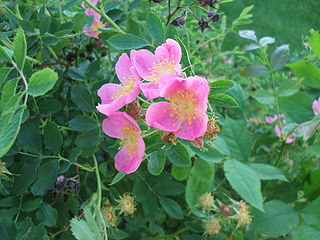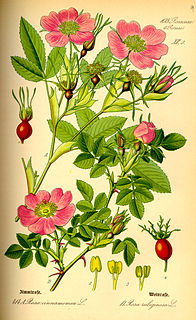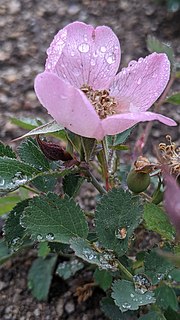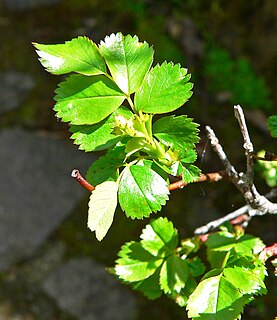
Rosa laevigata, the Cherokee rose, is a white, fragrant rose native to southern China and Taiwan south to Laos and Vietnam, and invasive in the United States.

Rosa rugosa is a species of rose native to eastern Asia, in northeastern China, Japan, Korea and southeastern Siberia, where it grows on beach coasts, often on sand dunes. It should not be confused with Rosa multiflora, which is also known as "Japanese rose". The Latin word "rugosa" means "wrinkled", referring to the wrinkled leaves.

Rosa rubiginosa is a species of rose native to Europe and western Asia.

Rosa arkansana, the prairie rose or wild prairie rose, is a species of rose native to a large area of central North America, between the Appalachian and Rocky Mountains from Alberta, Manitoba, and Saskatchewan south to New Mexico, Texas and Indiana. There are two varieties:

Vachellia farnesiana, also known as Acacia farnesiana, and previously Mimosa farnesiana, commonly known as sweet acacia, huisache, or needle bush, is a species of shrub or small tree in the legume family, Fabaceae. It is deciduous over part of its range, but evergreen in most locales. The species grows to a height of 15–30 feet (4.6–9.1 m) and grows multiple trunks. The base of each leaf is accompanied by a pair of thorns on the branch. Its flowers are used in the perfume industry.

Rosa nutkana, the Nootka rose, bristly rose, or wild rose is a 0.6–3.0-metre-tall (2–10-foot) perennial shrub in the rose family (Rosaceae).

Rosa chinensis, known commonly as the China rose, Chinese rose, or Bengal rose, is a member of the genus Rosa native to Southwest China in Guizhou, Hubei, and Sichuan Provinces. The first publication of Rosa chinensis was in 1768 by Nikolaus Joseph von Jacquin in Observationum Botanicarum, 3, p. 7, p. 55.

Rosa californica, the California wildrose, or California rose, is a species of rose native to the U.S. states of California and Oregon and the northern part of Baja California, Mexico. The plant is native to chaparral and woodlands and the Sierra Nevada foothills, and can survive drought, though it grows most abundantly in moist soils near water sources.

Rosa gymnocarpa is a species of rose native to western North America. It is known by the common names dwarf rose, baldhip rose, and wood rose. It grows in shady, damp, and rich forests.

Rosa minutifolia is a species in the genus Rosa. It is also known by the common names Baja rose, Baja littleleaf rose, and small-leaved rose.

Fritillaria atropurpurea is a species of fritillary known by several common names, including spotted fritillary, purple fritillary, spotted mountainbells, spotted missionbells, and leopard lily.
The South Sierra Wilderness is a federally designated wilderness area in the Southern Sierra Nevada, in eastern California. It is located 65 miles (105 km) northeast of Bakersfield, and is southwest of Owens Lake and Olancha.

Rosa majalis is a species of deciduous shrubs in the genus Rosa, native to forests of Europe and Siberia. It grows to 2 m. and yields edible hip fruits rich in vitamin C, which are used in medicine and to produce rose hip syrup.

Achnatherum pinetorum is a species of grass known by the common names pinewoods needlegrass and pine needlegrass. It is native to most of the western United States from California to Montana to New Mexico, where it grows in woodland and forest in rocky mountainous areas.

Rosa bridgesii is a species of rose known by the common names pygmy rose and Sierran dwarf rose. It is native to California, where it grows in the forests of the Sierra Nevada and surrounding mountains and foothills. It may also occur in Oregon.

Rosa pisocarpa is a species of rose known by the common name cluster rose or swamp rose. It is native to western North America from British Columbia to northern California, where it generally grows in moist habitats. It is a shrub sometimes forming a thicket, and growing up to 2.5 meters tall. The stems can be dark red or blackish and are often studded with straight, paired prickles at nodes. The leaves are each made up of several toothed oval leaflets, the terminal leaflet up to 4 centimeters long. The inflorescence is a cyme of up to 10 flowers with pink petals each up to 2 centimeters in length. The fruit is a rose hip about a centimeter wide. The hips are pear- or egg-shaped and borne in clusters, and are decorative in fall and early winter, when they are red or reddish-purple and contrast with yellow foliage. Fall foliage can be yellow or dark red.

Rosa spithamea is a species of rose known by the common names ground rose and coast ground rose. It is native to Oregon and California, where it grows in forest and chaparral habitats, especially areas recently burned.

Rosa woodsii is a species of wild rose known by the common names Woods' rose, interior rose, common wild rose, mountain rose, pearhip rose, and prairie rose.
Tradescantia pinetorum, the pinewoods spiderwort, is a species of Tradescantia and part of the Commelinaceae family.

Rosa villosa, the apple rose, is a species of rose. It was described in 1753.




















